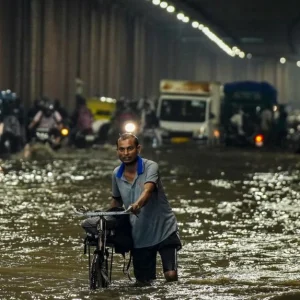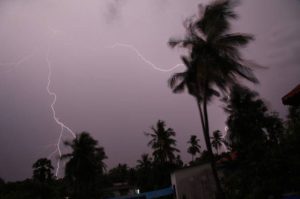New Delhi – The India Meteorological Department issued a Red Alert for Ghaziabad on Sunday morning as heavy rainfall continued to batter the Delhi-NCR region. This emergency weather warning highlighted the severity of meteorological conditions affecting Uttar Pradesh’s district adjoining the national capital.
The Red Alert for Ghaziabad remained in effect until 11 AM, after which authorities downgraded the warning to yellow-colored advisory. This systematic approach to weather alerts demonstrates the IMD’s commitment to public safety during extreme weather events.
Orange Warning System for Noida Region

Alongside the Red Alert for Ghaziabad, Gautam Buddh Nagar district, commonly known as Noida, received an orange alert designation. This dual warning system covered major urban centers in the National Capital Region, ensuring comprehensive coverage of potentially affected areas.
The orange alert for Noida complemented the Red Alert for Ghaziabad, creating a coordinated warning framework across adjoining districts. Both alerts followed similar timing, remaining valid until 11 AM before being reduced to lower-level warnings.
Unlike its neighboring areas, Delhi itself was not under any specific weather alert during Sunday morning hours. This differentiated approach showed how localized weather patterns can vary significantly even within the same metropolitan region, despite the Red Alert for Ghaziabad affecting nearby areas.
Historic Temperature Records Broken
Delhi-NCR is experiencing its coolest August in thirteen years, with temperatures dropping significantly below seasonal averages. The region recorded an average maximum temperature of 33.2 degrees Celsius through Saturday, marking the lowest August temperatures since 2012.
This remarkable cooling trend coincided with the Red Alert for Ghaziabad and associated weather systems bringing sustained rainfall to the region. The average maximum temperature in August 2012 was 33.1 degrees Celsius, making current conditions historically significant.
Comparative data reveals dramatic temperature differences from recent years. Last year’s August average maximum reached 34.1 degrees Celsius, while 2023 recorded 35.4 degrees Celsius. The Red Alert for Ghaziabad and associated weather patterns have contributed to this unprecedented cooling.
Current Weather Conditions and Forecasts
Sunday’s weather data showed Delhi recording a minimum temperature of 24.5 degrees Celsius, representing a two-degree drop below seasonal averages. The Red Alert for Ghaziabad reflected similar meteorological conditions affecting the broader region.
Humidity levels reached 81 percent by 8:30 AM, indicating moisture-laden atmospheric conditions supporting continued precipitation. The IMD forecast generally cloudy skies with moderate rain, expecting maximum temperatures to settle around 32 degrees Celsius.
Saturday’s minimum temperature of 23.8 degrees Celsius marked a 2.7-degree deviation below seasonal norms. These consistently below-average temperatures coincided with the weather systems prompting the Red Alert for Ghaziabad and regional precipitation patterns.
September Weather Outlook
The IMD predicts continued heavy rainfall across northwest India throughout September, particularly affecting Uttarakhand, south Haryana, Delhi, and north Rajasthan. This extended forecast suggests the weather patterns causing the Red Alert for Ghaziabad may persist into the coming month.
September’s anticipated weather conditions align with current patterns bringing relief from typically scorching August heat. The Red Alert for Ghaziabad represents part of broader meteorological shifts affecting the entire northwestern region.
Regional Impact and Urban Response


Heavy rainfall associated with the Red Alert for Ghaziabad has created waterlogged conditions throughout affected areas. Urban infrastructure faces challenges from sustained precipitation, requiring coordinated emergency response across municipal boundaries.
Also Read: Critical Yamuna Water Level Delhi Crosses Warning Mark Of 204.5 Metres with Flood Alert
The pleasant weather conditions, despite emergency alerts, have provided welcome relief from usual August heat. Residents across Delhi-NCR have experienced unusually comfortable temperatures coinciding with the Red Alert for Ghaziabad and associated cooling effects.
Alert System Evolution and Public Safety


The systematic approach to weather warnings demonstrates improved meteorological forecasting capabilities. The Red Alert for Ghaziabad followed established protocols for emergency weather communications, ensuring timely public notification of potentially dangerous conditions.
Downgrading alerts from red to yellow status after 11 AM showed responsive monitoring of changing conditions. This dynamic approach to weather warnings, exemplified by the Red Alert for Ghaziabad, helps maintain public safety while avoiding unnecessary panic.
Meteorological Patterns and Climate Implications


Current weather patterns represent significant departure from typical August conditions in Delhi-NCR. The Red Alert for Ghaziabad reflects broader atmospheric changes bringing unprecedented cooling to the region during traditionally hot summer months.
Extended periods of below-average temperatures suggest possible shifts in regional climate patterns. The meteorological conditions necessitating the Red Alert for Ghaziabad may indicate evolving monsoon dynamics affecting northern India.
Infrastructure and Emergency Preparedness
Urban areas under weather warnings have activated emergency response protocols to address potential flooding and transportation disruptions. The Red Alert for Ghaziabad triggered coordinated efforts between municipal authorities and emergency services.
Waterlogging concerns in urban areas require ongoing monitoring and rapid response capabilities. Emergency preparedness systems activated during the Red Alert for Ghaziabad demonstrate improved coordination between meteorological services and local authorities.
Final Statement: Adapting to Changing Weather Patterns
The Red Alert for Ghaziabad and associated weather phenomena represent remarkable meteorological events affecting millions across Delhi-NCR. Record-breaking temperature drops combined with heavy rainfall have created unprecedented August conditions.
As September approaches with forecasts predicting continued heavy rainfall, authorities maintain vigilance for similar emergency situations. The successful management of current weather challenges, including the Red Alert for Ghaziabad, provides valuable experience for future extreme weather events.
This weather pattern offers both relief from summer heat and challenges for urban infrastructure, requiring balanced approaches to emergency management and public safety throughout the region.

